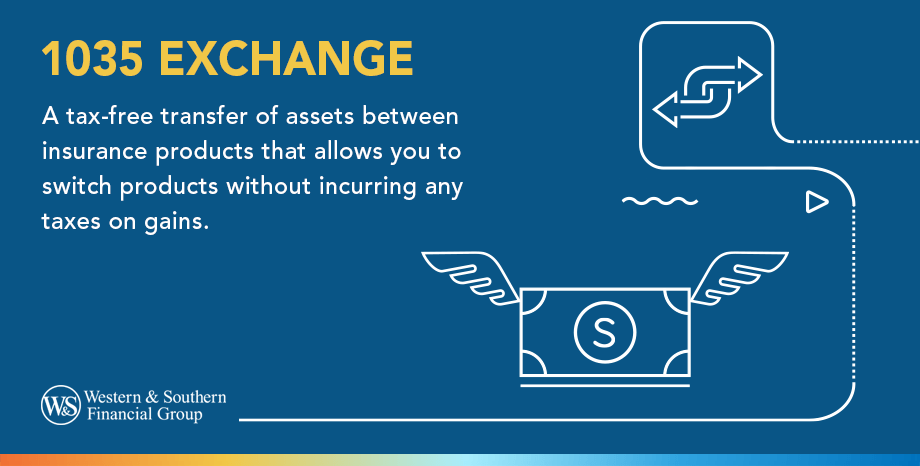

Table of Contents
Key Takeaways
- A 1035 exchange allows you to transfer assets from one insurance product to another without triggering immediate taxation.
- It can be used to switch to a more suitable insurance policy with additional features, better guarantees, lower fees, or specific investment options.
- A 1035 exchange defers taxation on any gains, preserving your basis and avoiding taxable events.
- There are important considerations, such as matching names, outstanding loans, and potential downsides, when completing a 1035 exchange.
- It's advisable to consult with a financial representative to navigate the details and ensure the exchange meets your needs.
Some life insurance policies are meant to last a lifetime, but that's not always what happens. Insurance strategies and products continue to evolve, and things may change in your own life. If you already have a life insurance policy or annuity contract, you may find there are options better suited to your needs. That's where a 1035 exchange can help.
1035 Exchange Defined
A 1035 exchange is a like-kind exchange between insurance products. In other words, it allows you to transfer assets directly from one contract to another instead of cashing it out (or "surrendering"). If you simply cash out, receive funds and buy a new contract, you may face tax consequences as a result.
For example, any gains in your policy might be taxed as ordinary income when you take a distribution. But when done, a 1035 exchange may allow you to avoid immediate taxation.
A 1035 exchange offers the ability to complete a tax-free exchange into a new life insurance policy or annuity contract. Sometimes, you can shift between types. For example:
- A life insurance policy can transfer to another life insurance policy, annuity or endowment contract (another type of life insurance policy).
- An endowment contract can be exchanged for an annuity.
If you no longer need life insurance coverage and would prefer to use an annuity instead, you can often do so. However, tax rules typically don't allow you to make transfers in the opposite direction: You cannot make a 1035 exchange from an annuity contract into a life insurance policy.
When Should I Consider a 1035?
For most people, the goal of a 1035 exchange is to switch to a more suitable contract while avoiding tax consequences. Since your initial purchase, you may have found insurance policies with additional features, specific guarantees (like living benefits that better meet your needs), lower fees or particular investment options. A 1035 exchange provides the flexibility to take advantage of these products.
Assuming you do not have any outstanding loans and you complete the transfer, a 1035 exchange is not a taxable event. As a result, you defer taxation on any gains.
What's more, those gains are defined as the difference between your policy's cash value and your basis (total insurance premiums so far). If your basis is higher than your current cash value, you may benefit from preserving that basis, since you'll have no taxable gains. But if you cash out and buy a different policy instead of using 1035 to transfer, you'll likely create a taxable event.
What Else Should I Know?
There are a lot of moving parts and things to think about when completing a 1035 exchange. Ask a financial representative who is licensed in your area to help guide you through the details, which include:
Matching names: A 1035 exchange is typically only possible if you use the same owner and insured (or annuitant) on both policies. Changes may disqualify you, so review both policies carefully and ask your Certified Public Accountant (CPA) to verify the details.
Loans: Outstanding loans may make it difficult to complete a 1035 exchange. Some insurance companies are hesitant to accept loans via a 1035, so that may limit your options. Also, loans may create tax consequences, potentially reducing the effectiveness of a 1035.
Your needs: It may be possible to get what you need from your existing policy. Ask your financial representative what options are available to you. You might be able to add riders, change your death benefit or take other steps to adjust your current policy.
Other stipulations: Before you decide to switch, review any potential downsides of doing so. For example:
- You may have to pay surrender charges to get out of your existing policy.
- Your health may have declined since you originally purchased coverage.
- Buying insurance at an older age may require higher premiums, while your old policy was issued at a younger age.
- Any high-water marks — or the point(s) of greatest value in a given period of time — on income annuities might reset. (Although that might not matter if your account balance is as high or higher than those high-water marks.)
- Other provisions, guarantees and benefits may change — for better or worse.
The Bottom Line
Moving from an old policy to a new one can bring improvements, but you could also lose valuable benefits. It's generally a good idea to keep your existing coverage in place until both policies are issued and you can confirm that the 1035 exchange is going to work. Once you're sure a new policy will better address your needs — and that you can avoid the tax consequences — ask your financial representative about moving forward.


















